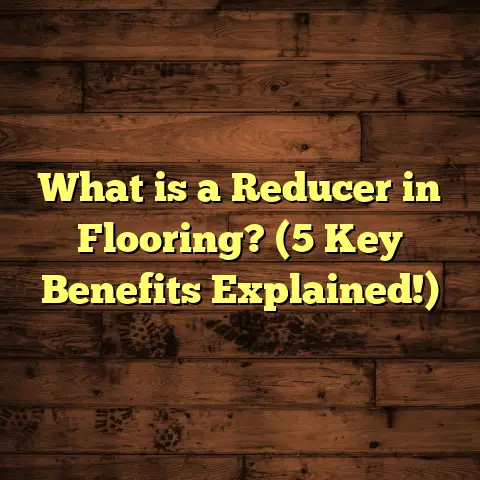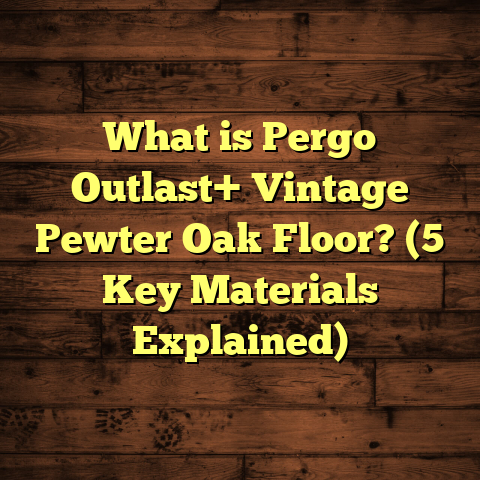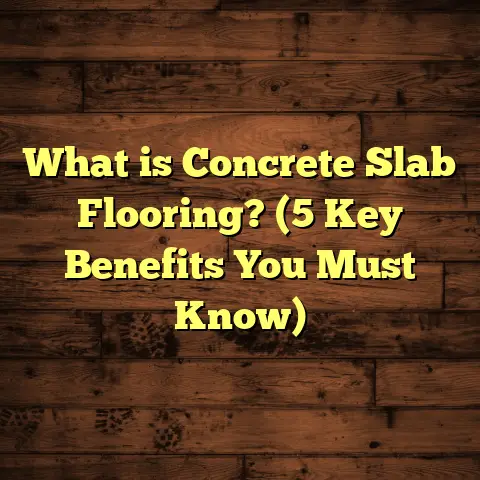What is Solid Surface Flooring? (5 Benefits You Didn’t Know)
Imagine you’ve just moved into a new place or started planning a major renovation. You’re standing in an empty room, looking at the bare subfloor, wondering: “What type of flooring would look great, last a long time, and be easy to maintain?” If you haven’t explored solid surface flooring yet, you might find it’s exactly what you need. I want to walk you through what solid surface flooring is, share some benefits you probably haven’t heard about, and tell you some stories from my experience as a flooring contractor that might help you decide if this is right for your home.
What is Solid Surface Flooring?
Solid surface flooring is a man-made material created by combining natural minerals such as alumina trihydrate (ATH) with acrylic resins and pigments. The result is a dense, non-porous sheet or tile that looks smooth and can mimic natural stone or other textures. Unlike tile or hardwood, it installs as large sheets or tiles with seamless joints, giving your floors a sleek uniform appearance.
The thickness of solid surface flooring sheets varies but typically ranges from 1/4 inch (6 mm) to 1/2 inch (12 mm). Sheets often come in sizes like 12 feet by 5 feet (about 3.7 meters by 1.5 meters), making it possible to cover large areas without many seams.
Prices for solid surface flooring materials usually fall between $6 and $15 per square foot (sq ft). Installation adds another $3 to $7 per sq ft due to the specialized skills required for seamless fitting and bonding.
This material was originally popularized for countertops and bathroom vanities because of its durability and clean look, but over the past decade, it’s become a strong contender for flooring in homes and commercial spaces as well.
A Closer Look at the Material Composition
One thing that sets solid surface apart from other synthetic materials is its composition. It’s primarily made up of:
- Alumina Trihydrate (ATH): This mineral gives the material strength and fire resistance.
- Acrylic resin: Acts as the binder that holds the minerals together and allows the material to be molded.
- Pigments: Provide color and pattern options, allowing for endless design possibilities.
- Fillers and additives: Enhance durability, UV resistance, and texture.
Because it is non-porous and dense, solid surface flooring does not absorb moisture or stains like natural stone or wood can. This makes it highly hygienic—an important feature for areas prone to spills or humidity.
How Solid Surface Flooring Is Made
Understanding how it’s manufactured might sound technical, but it’s pretty interesting. The components are mixed into a slurry, poured into molds or sheets, then cured under heat and pressure. This process creates a uniform solid slab that can be sanded and polished to different finishes — from matte to high gloss.
Some manufacturers add texture or patterns during this process. For example, they can imprint wood grain or stone veining directly onto the surface or embed colored flecks within the material.
5 Benefits of Solid Surface Flooring You Didn’t Know
You might already know that solid surface floors are durable and look nice, but here are five benefits that tend to surprise most people:
1. Seamless Installation Means Fewer Problems Down the Road
One feature I love about solid surface flooring is how it installs with virtually no visible seams. Unlike tiles that have grout lines or planks that have gaps, solid surface sheets are joined with special adhesives and then sanded smooth to create a continuous floor.
Why does this matter? Seams are often where water seeps in, dirt collects, and mold grows. By reducing these weak points:
- You get floors that are easier to clean.
- You prevent moisture damage.
- You reduce the risk of bacteria buildup.
I once worked on a spa renovation in Miami where the client wanted floors that could handle constant water exposure without staining or mold. Solid surface flooring was perfect — after two years, the floor still looked flawless with no mold issues.
2. Resistant to Scratches, Dents, and Impacts
Solid surface flooring is tougher than most people realize. The blend of acrylic resin and minerals results in a material that resists dents and scratches better than vinyl or laminate.
For example, we installed this flooring in a family’s playroom in Atlanta where kids frequently dragged toys around. After a year of heavy use, there were barely any scratches visible. Compare that to vinyl floors which can tear or laminate that can chip easily under similar conditions.
This makes it a great choice for:
- Homes with children
- Pet owners
- Commercial spaces with high foot traffic
3. Maintenance Is Almost Too Easy
If you hate scrubbing floors or dealing with special cleaners, solid surface floors will feel like a dream. Thanks to their non-porous nature:
- Dirt doesn’t embed in the surface.
- Spills wipe away quickly.
- No need for sealing or waxing like hardwood or stone.
In one elderly homeowner’s house I worked on in Oregon, ease of maintenance was the top priority. She appreciated that she could keep her floors looking brand new using just mild soap and water—no expensive products or labor-intensive upkeep needed.
4. Design Freedom Like You’ve Never Seen
When you want your home to reflect your style but don’t want to compromise on function, solid surface flooring offers endless possibilities. The material can be manufactured in nearly any color or pattern:
- Marble-like veining
- Wood grain textures
- Bold colors like deep blues or greens
- Subtle speckles or flecks for texture
Because it’s custom-made, you can even order designs printed directly onto the sheets for something truly unique.
One client in San Francisco wanted floors that looked like reclaimed wood but had the durability of stone. Solid surface flooring gave her exactly that — the perfect balance of beauty and practicality.
5. Longevity That Outperforms Many Other Floors
One of solid surface flooring’s best-kept secrets is its lifespan. With proper installation and care, it can last 20 to 30 years or more without needing replacement.
Compare this with laminate floors which often last just 10 to 20 years before showing wear or hardwood which can last longer but requires refinishing.
Plus, many manufacturers offer warranties ranging from 10 up to 25 years, giving homeowners peace of mind.
I installed solid surface flooring in a commercial office in Boston about eight years ago; it still looks as good today as it did on day one despite heavy daily foot traffic.
Detailed Case Study: Solid Surface Flooring in a Residential Kitchen Remodel
Let me take you behind the scenes on a project I worked on last year in Dallas. A couple wanted to remodel their kitchen but had two main concerns:
- Their old hardwood floor was water-damaged near the sink.
- They needed something low maintenance because they both work long hours.
We suggested solid surface flooring because it’s waterproof and easy to clean.
The installation process took about three days for their 300 sq ft kitchen area:
- Day 1: Subfloor prep and leveling.
- Day 2: Sheet installation with seamless bonding.
- Day 3: Final sanding and polishing.
The total cost came out to roughly $12 per sq ft installed—right in the mid-range for kitchen flooring options.
After six months, they reported zero issues with moisture damage or staining despite daily cooking messes and spills. The floor’s seamless look also made their kitchen feel more spacious and modern.
Frequently Asked Questions About Solid Surface Flooring
Is solid surface flooring slippery when wet?
Some finishes can be slick if wet, especially glossy ones. However, many manufacturers offer textured surfaces or anti-slip treatments to improve traction. For bathrooms or entryways where wetness is common, opting for a matte or textured finish is smart.
Can scratches be repaired?
Small scratches can often be buffed out professionally using fine abrasives or polishing compounds. This restores the original finish without needing to replace entire sections. Deep gouges are tougher but usually rare thanks to the floor’s durability.
How does it react to heat?
Solid surface flooring is heat resistant up to a certain point (usually around 300°F or 149°C). It won’t scorch like vinyl under hot pans but still avoid direct contact with open flames or extremely hot objects.
Is it environmentally friendly?
While synthetic, many brands focus on low volatile organic compound (VOC) emissions during manufacturing, ensuring better indoor air quality. Some manufacturers also use recycled content in their products and have recycling programs for old materials.
Comparing Solid Surface Flooring With Other Popular Options
Here’s how solid surface stacks up against common types of flooring:
| Feature | Solid Surface | Hardwood | Laminate | Vinyl | Tile |
|---|---|---|---|---|---|
| Durability | High | Medium-High | Medium | Medium | High |
| Water Resistance | Excellent | Poor | Poor | Good | Excellent |
| Maintenance | Low | Medium | Low | Low | Medium |
| Installation Complexity | High | Medium | Low | Low | High |
| Cost (Material + Install) | $9 – $22/sq ft | $12 – $23/sq ft | $4 – $11/sq ft | $3 – $11/sq ft | $10 – $27/sq ft |
| Lifespan (Years) | 20 – 30 | 25 – 50 | 10 – 20 | 10 – 20 | 20 – 50 |
| Design Variety | Very High | Moderate | Moderate | High | High |
If you value durability combined with design flexibility and low maintenance—and don’t mind paying for professional installation—solid surface is worth serious consideration.
My Tips for Choosing Solid Surface Flooring
If you decide to go with solid surface flooring, here are some pointers I wish every homeowner knew before installation:
- Work With Experienced Installers: The seamless joints require precision cutting and bonding techniques.
- Prepare Your Subfloor Well: It must be perfectly flat; irregularities will show through the thin sheets otherwise.
- Choose Finish Wisely: Consider textured finishes in high-traffic or wet areas.
- Plan Your Budget: Factor in both material and labor costs upfront.
- Request Samples: Always see samples under your home’s lighting before ordering large quantities.
- Ask About Warranties: Understand coverage terms and what maintenance might void them.
- Maintenance Routine: Use mild cleaners regularly; avoid abrasive tools that could dull the finish over time.
More Personal Stories From My Flooring Projects
One of my favorite installations was at a yoga studio in Portland where they wanted floors that were soft underfoot yet durable enough to withstand heavy mats and frequent cleaning. Solid surface flooring met those needs perfectly—it provided some cushioning while resisting sweat stains and moisture from daily class use.
Another memorable project was a boutique hotel lobby in New York City that wanted a unique marble look but without the fragility of real stone tiles. We used solid surface flooring with custom veining patterns printed directly into the sheets. Guests often complimented how luxurious yet modern the floors looked—without realizing they were man-made!
Environmental Impact & Sustainability Insights
You might wonder if solid surface flooring is eco-friendly since it’s synthetic. The truth is nuanced:
- Production: Some factories now use renewable energy sources and reduce waste through precise manufacturing.
- Materials: Many brands incorporate recycled content from post-consumer plastics or industrial byproducts.
- Indoor Air Quality: Certified low VOC emissions improve air quality compared to some wood finishes or vinyl adhesives.
- Longevity: Long lifespan means fewer replacements—less landfill waste over time.
- Recyclability: End-of-life recycling programs exist but vary by manufacturer; ask your supplier about options near you.
Given these factors, solid surface flooring can be considered a responsible choice for eco-conscious homeowners who prioritize durability and indoor health.
Final Thoughts From Someone Who’s Walked Hundreds of Floors
Having installed many types of floors over the years—from hardwoods to tiles—I can confidently say solid surface flooring stands out as an excellent blend of style, function, and durability.
If you want floors that stay beautiful without constant care; resist moisture and damage; offer design freedom; and last decades—it should definitely be on your shortlist.
Feel free to reach out if you want advice tailored specifically to your project location or budget! I’m happy to share more insights based on my direct experience working across different climates—from humid Florida homes to dry Colorado cabins—and the unique challenges each presents.
What floor type are you considering now? Or maybe you’ve tried solid surface in your home already? Let’s chat—I’d love to hear your story!





